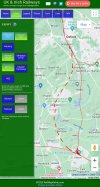ChewChewTrain
Member
- Joined
- 27 Jun 2019
- Messages
- 350
If you could rewrite history so that Victorian landowners weren’t so reactionary and thus Abingdon had a mainline presence, what would the best configuration be? Deviate Didcot to Oxford to the west? Deviate Didcot to Swindon to the north? Or do both, making Abingdon a junction somewhat like Didcot Parkway actually is today?
No “rules” for this thread. It’s the Speculative Discussion forum, so please: go wild, and there are no wrong answers!
No “rules” for this thread. It’s the Speculative Discussion forum, so please: go wild, and there are no wrong answers!

